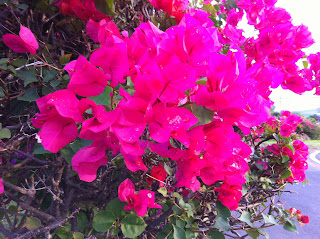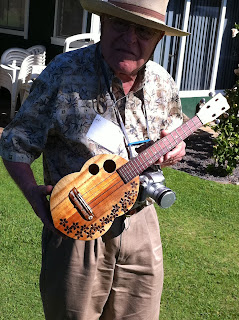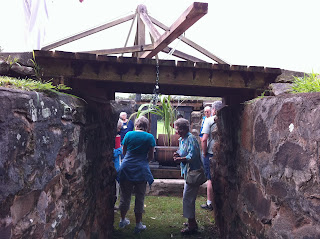Before we left for Molokai, my friend Mary suggested I read Molokai, by Alan Brennert, and I’m so glad I followed her advice. This novel tells the story of a young girl ripped from her family and sent to live at Kalaupapa, where victims of Hansen’s Disease were sent to live in isolation from the rest of humanity. There are many more novels and first person accounts concerning Kalaupapa and reading any of them will make a visit there even more meaningful.
In 1865 King Kamehameha V signed the “Act to Prevent the Spread of Leprosy,” which authorized forced isolation of those who showed symptoms. Inspectors visited schools regularly, sending children who showed signs of the disease, as well as adults, to a holding pen in Honolulu before they were shipped to the peninsula, Kalawao at first, and then to the less windy side at Kalaupapa.
How would you answer the question of what to do when a contagion breaks out?
No one knew what caused leprosy, nor how to treat it, so having it was a death sentence. No one knew it was one of the least contagious of all modern-day communicable diseases. So fathers were ripped away from their families, leaving mothers and children to fend for themselves. Mothers were torn away. Some parents lost all their children, one by one. If two residents in isolation at Kalaupapa had a child, that child was immediately taken away so as not to be inflicted. 8,000 patients have lived at Kalaupapa.
Adding to the pain is the knowledge that Native Hawaiians who made this place their home prior to 1865 were asked to re-locate and so they had to leave the homes they loved to make way for the patients. When the first patients came there was no housing, no clothing, no food, no medication, no law and order.
Imagine the spirit of heartache that surrounds this place.
One also feels the sacred spirits here as well. Quoting the National Historical Park pamphlet: “…a remarkable sense of community endures through the countless stories of love, compassion, support, faith, and perseverance among the afflicted as well as those kokua (helpers) who came to serve.” Many people come here not only to learn what transpired, but also for spiritual renewal, an understanding of service and sacrifice.
In 1873 Father Damien volunteered to come to Kalaupapa and later sent for sisters to come help as the young girls and women sent there were prey of the less genteel of the men patients and he wanted them to be safe. He eventually succumbed to the disease himself. He was canonized in 2009 and will soon become a saint. Mother Marianne Cope is on her way to becoming canonized as well.
In 1949, forced isolation at Kalaupapa ended, but where would those residents, many severely disfigured, be welcomed? The isolation policy was finally abolished in 1969 so residents could travel or move elsewhere, but most choose to remain in the only home they’ve known.
As our group flew in, plane by plane load, we noticed the beauty of the peninsula, bordered on one side by the high cliffs which made this at one time such an effective prison. When the first patients came, they encountered a barren and windswept place, but now abundant flora exists.
Patrick Boland, who was a friend of patient Richard Marks for many years before his passing, was our guide for the tour. He had spoken to us the night before about the history of Kalaupapa and his impressions, having visted there often and speaking with patients.
If you go to Kalaupapa, you must be sponsored by one of the patients. In our case, we are indebted to Gloria Marks for our visit. You may also be able to visit through Damien Tours. 100 visitors a day are permitted. Some come by plane, as we did, and others hike down the cliff or ride mules. No one can come without invitation and those who try are sent back up the trail with warnings and/or fines.
The first thing anyone encounters on the road from the airport to the town are the fields of headstones. There are also many resting places without headstones as many patients were abandoned by their families and there was no one to mourn when they died. We were told to remember that many people died rapidly because there was no treatment available and grave spots filled up.
Kalaupapa Settlement’s residential community is lovely and quiet and we enjoyed a stop at the snack bar to stimulate the economy there by purchasing a beverage or ice cream snack. At the boat landing we could imagine the barges bringing food and supplies and new patients. Close by is the Long House, the visitor-patient meeting hall, where loved ones were separated by a pane of glass, and the remains of the hospital. We also visited the St. Francis Church, and the bookstore. We saw the Bishop Home for Girls and the monuments to Mother Marianne and Father Damien. I saw the beach where the character in my novel surfed and I imagined her living in one of the small homes.
Then the old schoolbus transported us to Kalawao to see the Siloama Church and St. Philomena Church, the site of the old Baldwin Home for Boys and the remains of the U.S Leprosy Investigation Station. We marveled at Father Damien’s building skills, and noted the spit holes in the floor so churchgoers could get rid of their mucus while worshipping. Next to the St. Philomena Church are even more gravesites. Many of the headstones were from 1926-1929 and many more graves lie unmarked.
A new Kalaupapa Memorial will be located at the Old Baldwin Home site across the street from St. Philomena Church. Building materials were already in place at the time of our visit. We ate our picnic lunch in the park and were entranced by the lovely landscape and vistas overlooking the two islands off the coast and the cliffs straight up on our right.
Also on the island is a volcanic crater which is featured in a scene of my novel but the timing of our day did not allow us to visit either that or the lighthouse.
After flying out again, plane by plane load, we took a trip to the overlook topside to see Kalaupapa from another perspective. Two whales breaching, a gift from nature, added to the spiritual aspect of our day.
The National Park System and the state of Hawaii are deciding what to do with Kalaupapa Peninsula when the last patient has passed. My husband and several others were given a survey to fill out regarding the decisions to be made, one of which is to continue to limit the amount of visitors in any one day. Every one of our group was humbled and grateful for the opportunity to visit.
I leave you with the words of Henry Nalaielua, a Kalaupapa resident: “Don’t desecrate what happened here, not because of my lifetime, but because of those who came before me…I would really like to see this place stay sacred…sacred in honor of those who died here because of the disease, those who fought for allowances, fought for their clothing, fought for their medication, fought for their freedom.” (National Park pamphlet)































